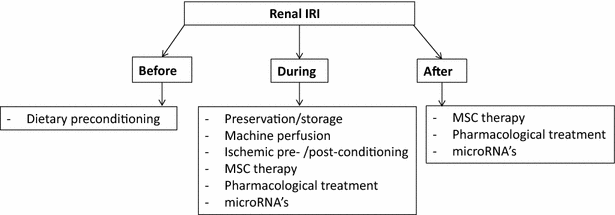Improving the outcome of kidney transplantation by ameliorating renal ischemia reperfusion injury: lost in translation?
- PMID: 26791565
- PMCID: PMC4721068
- DOI: 10.1186/s12967-016-0767-2
Improving the outcome of kidney transplantation by ameliorating renal ischemia reperfusion injury: lost in translation?
Abstract
Kidney transplantation is the treatment of choice in patients with end stage renal disease. During kidney transplantation ischemia reperfusion injury (IRI) occurs, which is a risk factor for acute kidney injury, delayed graft function and acute and chronic rejection. Kidneys from living donors show a superior short- and long-term graft survival compared with deceased donors. However, the shortage of donor kidneys has resulted in expansion of the donor pool by using not only living- and brain death donors but also kidneys from donation after circulatory death and from extended criteria donors. These grafts are associated with an increased sensitivity to IRI and decreased graft outcome due to prolonged ischemia and donor comorbidity. Therefore, preventing or ameliorating IRI may improve graft survival. Animal experiments focus on understanding the mechanism behind IRI and try to find methods to minimize IRI either before, during or after ischemia. This review evaluates the different experimental strategies that have been investigated to prevent or ameliorate renal IRI. In addition, we review the current state of translation to the clinical setting. Experimental research has contributed to the development of strategies to prevent or ameliorate IRI, but promising results in animal studies have not yet been successfully translated to clinical use.
Figures
References
Publication types
MeSH terms
LinkOut - more resources
Full Text Sources
Other Literature Sources
Medical


